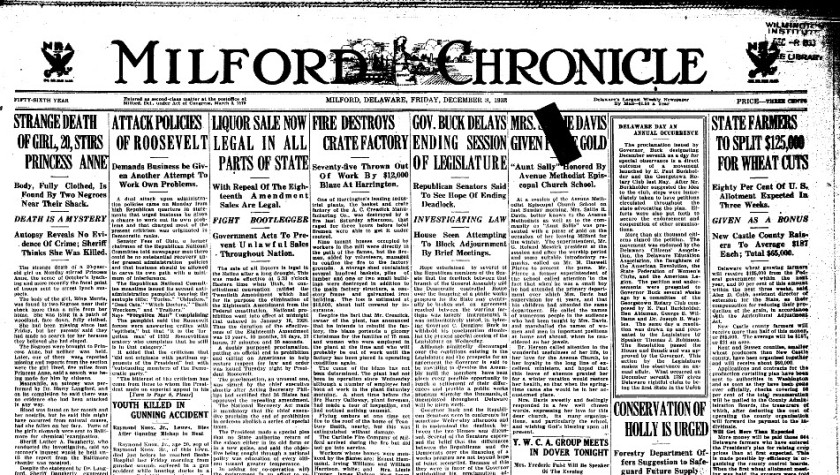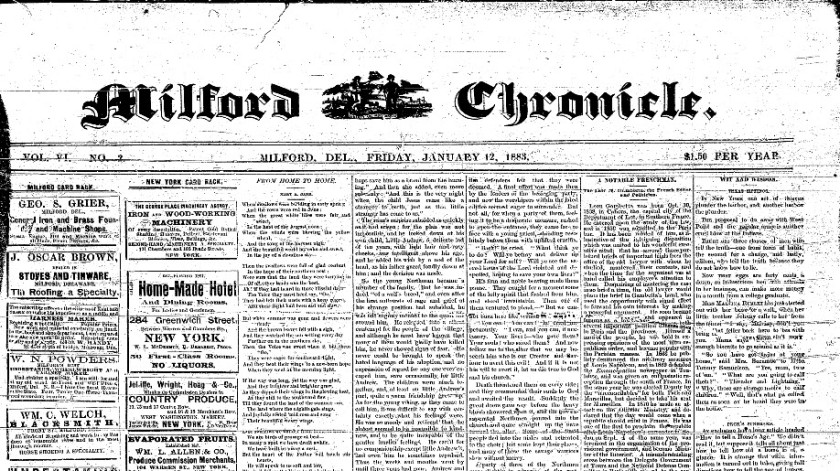When the Spanish Influenza hit Delaware in 1918, the surge devastated Wilmington and overwhelmed city hospitals. With sickness everywhere that October, doctors and ambulances could not keep up. Gongs rang continuously on the streets day and night as the emergency vehicles rushed the most critical cases to Homeopathic, Delaware, and Physicians’ and Surgeons’ hospitals. This never-ending stream of sufferers quickly overloaded the City’s healthcare system.

Once the sickest arrived at the hospital, the medical providers on the frontline of caring for the stricken, the nurses, faced grim danger grappling with the invisible virus. The war had already thinned their ranks, but now on the homefront, they battled an added enemy. Nevertheless, the exhausted professionals struggled around-the-clock in chaotic, unpredictable conditions, under extreme pressure once the surge walloped Wilmington. All they could offer was palliative care and the little relief that the pharmaceuticals and therapies of the age might provide while realizing they too could become infected, no matter how careful they were.
A Plea to Help the Nurses
The first plea for help came from Dr. Robert E. Ellegood, president of the Wilmington Board of Health. In this deteriorating situation, the City urgently needed nurses to care for the mounting caseload, he reported as the first two deadly weeks of October got painfully underway. Anyone who could help in any conceivable way – trained or not — would be “a godsend by giving some exhausted nurse a chance to take a little rest.”
Social distancing or personal protective equipment wasn’t an option for these early 20th century caregivers providing hands-on, bedside attention to the sickest people in the City. Many of these unheralded heroes of these days fell ill, some dying while caring for patients.

A Wilmington newspaper sketched out the hopeless situation in those early weeks of October, as the virus raged unchecked in the City. It seemed like people in Wilmington were dropping dead everywhere, and surely in such desperate hours, these women, many young nurses in training, came to their own terms with the death that was all around them. As the toll mounted for these practitioners too, the Evening Journal reported that three graduate nurses of the Delaware Hospital died, “from disease which they contracted while caring for patients.” 1
After sixteen harrowing days, there was a glimmer of hope for the clinicians. On October 17, the Evening Journal said: “One of the best and happiest pieces of news in regards to the epidemic situation is that the heroic nurses who have been struck down while ministering to others suffering the influenza are now getting well and the number of sick nurses is rapidly lessening.” No more had been added to the “pathetic list of nurses who have died as gloriously as any soldier on the battlefield,” the Journal remarked. In place of 36 sick providers, the Delaware Hospital reported only fifteen of their nurses on the influenza list, and none of those were critical.

Other city hospitals reported similar improvements. The Physicians’ and Surgeons’ Hospital had only two nurses who were influenza patients, and at Homeopathic Hospital, none were sick. Also, there had been no deaths from influenza among the Homeopathic Hospital nurses. The State Hospital for the Insane reported that six nurses were on the sick list.
As the dark pall slowly lifted in the second half of the month, the Superintendent of the Delaware Hospital, Barron E. Lyons, wrote that the outbreak “took one nurse after another until out of a quota of forty-two scarcely a dozen remained. These had to care not only for the one hundred twenty usual patients in the hospitals but their own sick sisters as well,” he noted. “When our first pupil nurse died, not one nurse flinched or showed a sign of fear, but each kept on with her work as loyally as ever,” the October 19, 1918, letter to the editor stated.
We should remember these women — many young student nurses or emerging professionals — and the sacrifices they made fighting for public health in Wilmington as a global pandemic raged unchecked all around them 102-years-ago. Thus, as part of our continuing series examining the outbreak on Delmarva, we are compiling a registry of the nurses who made the ultimate sacrifice.
The Fallen Nurses
Here is what we have developed thus far, and we will update this as more data is collected once the Delaware Public Archive reopens.2
- Anna G. Boemann – The Delaware Hospital class of 1915 graduate, Miss Bowman, 28, died Monday morning, October 14, 1918, at the hospital after a week’s illness from pneumonia She became sick while caring for ill nurses. Her home was in York PA and the paper noted that she was considered a splendid nurse. 3
- Elsie A. Bogan – The Delaware Hospital Graduate Nurse (class of 1905) died on October 7, 1918, at her home at 4506 Harrison Street after a week’s sickness. The 32-year-old had volunteered for overseas military duty but worked at the hospital while waiting for her call. The daughter of Mr. and Mrs. Paul J. Bogtan was buried in her white uniform and nurse’s cap at St. Joseph’s.4
- Lille J. Campbell – For 14-years, Miss Campbell was a visiting nurse with the Associated Charities in Wilmington. At the end of October, she suffered an attack of influenza, and acute appendicitis followed. While recuperating at the home of her sister at 2312 W. 18th Street, Mrs. H. W. Roberts, her condition declined. So, the attending physician decided that the only chance of saving her was an operation, and he had her moved to the hospital. Following surgery, the 44-year-olds weakened condition was against her, and she died on November 3, 1918. She was laid to rest at Mt. Salem M.E. Church. Because of her work in the City, she was well known and had a large circle of friends.
- Martha Corbitt – The thirty-three-year-old nurse, worked as an occupational nurse at the Betheleheml Steek Works at New Castle. Miss Corbitt died on October 26, 1918
- Mary Anna Dwyer – The Delaware Hospital Graduate (class of 1918) died Sunday, October 13, 1918, in Delaware City at the home of a patient she was nursing. The twenty-two-year-old had resided in Kennett Square, PA.
- Carrie Elvera Dybeck – This young lady, a 24-year-old student nurse at the Delaware Hospital, died on October 9, 1918, at her home in Hartly. She was “a younger sister of Miss Ruth Dybeck, the nurse who had died from the malady a few days ago and had taken care of her sister during her illness,” the Evening Journal reported..
- Ruth Dybeck – A new student nurse from Hartly, Miss Dybeck, 28, had entered the Delaware Hospital to start her training on September 15, a week or two before the influenza surge hit Wilmington. On September 25, she fell ill, and her sister, Carrie Dybeck, a student nurse with nine-months experience, nursed her through the sickness. But at 5:30 p.m. on October 3, 1918, she passed away.
- Ethel Tammany – Contracting her sickness while administering to the suffering of others at the New Century Club, an emergency hospital, she died on Oct. 9, 1918. The twenty-two years-old graduate of the Delaware Hospital graduated in 1917 at the head of the class, a distinction she justly deserved. The “faithful worker” was laid to rest at Riverview cemetery.
- Also, at least one physician, Dr. E. I Nichols, No. 1623 Mt. Salem Lane, died from influenza, which he contracted while treating epidemic victims.
The so-called Spanish Influenza Pandemic of 1918 resulted in about 794 deaths in the City, and it seemed like people were dropping dead everywhere. Surely these untiring workers at a time of the greatest need had to come to terms with the death that was all around them in the Delaware hospitals. 5

For More on the Spanish Influenza Pandemic
This is part of an ongoing series on the pandemic of 1918. For more see our Spanish Flu Archive
Telephone Operators Were Essential Workers in 1918
Wilmington’s Ambulance Service Struggled to Keep-Up
Endnotes- “Three Nurses, one Doctor Are Dead: Pneumonia Continues to Claim Many Victims in City and Vicinity,” Evening Journal, Oct. 15, 1918, https://bit.ly/2S70pCD[↩]
- State of Delaware, Bureau of Vital Statistics, Certificate of Death, www.familysearch.org, accessed April 24, 2020. [↩]
- State of Delaware, Bureau of Vital Statistics, Certificate of Death, www.familysearch.org, accessed April 24, 2020.[↩]
- “The Supreme Sacrifice,” The Trained Nurse and Hospital Review, Volumes LX and LXI, January to December 1918[↩]
- “What Red Cross Did to Stop Influenza Spread,” Evening Journal, Feb. 15, 1919, https://bit.ly/2S70pCD[↩]







